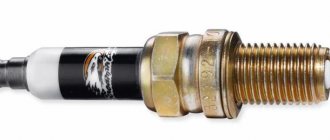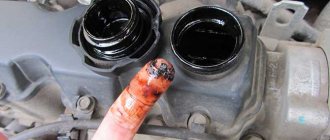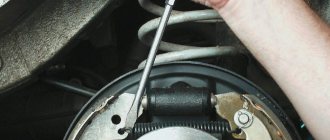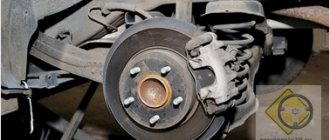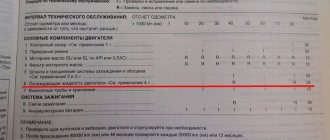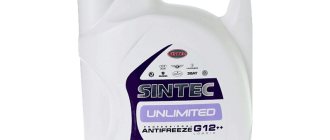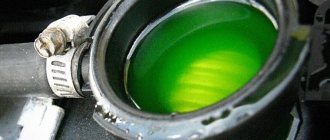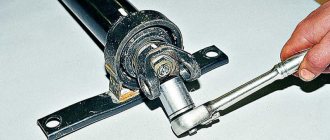Car brake fluid is considered to be a number of important fluids that are used for the proper operation of the vehicle. Let us immediately note that the efficiency, as well as the reliability of the brake system in a car, directly depends on the quality of this technical fluid. If you look at the service book of any car, it will contain information about how long it takes to completely replace the brake fluid. As a rule, it is enough to undergo this procedure no more than once every two years.
General position
Manufacturers recommend doing this with such frequency for a reason, since they regularly carry out numerous tests and calculations. Often, novice motorists do not understand why change the brake fluid when the brakes work and its level does not decrease. After years of use, it may lose its properties.
Due to the low cost, making a replacement even at a car service will not be a burdensome task for you. Some people neglect this procedure, trying to save as much as possible on the operation of their “iron friend,” remembering the nineties when buying such a liquid was really problematic.
How to check the brake fluid in a car?
The services use a brake fluid tester; it can be purchased at an auto store. It is necessary to make a small sampling of material, or lower the device into the expansion tank on the master brake cylinder. It determines the main quality indicator - boiling point. Externally, it is difficult to estimate how much moisture is in the brake fluid. The color practically does not change, clouding does not occur.
This is interesting: Tightening the cylinder head bolts: order, force
The normal value is 175 °C and above. If the liquid boils at a lower temperature, it is dangerous to continue operating the car.
Another way is to visually check the brake fluid. Even if the color remains the same, the worn-out liquid becomes cloudy and a suspension appears in it. These could be wear products from the system or flakes from additives that have lost their effectiveness. It's good to have a small amount of fresh brake fluid of the same brand for comparison.
Why is planned replacement carried out?
Brake fluid in any car, even a passenger car, is invariably exposed to difficult operating conditions, and with frequent city driving it can quickly heat up to 150 degrees. If you travel with a trailer and on bad roads, the operating temperature can be much higher. All modern fluids for the hydraulic brake system can easily withstand these loads, but you need to take into account the hygroscopicity of the design, that is, the fact that DOT4 will be consumed during operation. This will subsequently lead to a significant decrease in the boiling point of the brake assembly.
It is important to understand that if several percent of the water leaves the liquid over a year of use, the boiling point will be reduced to 50 degrees.
If the brake fluid boils while driving a car, this will lead to the formation of air bubbles, which will be squeezed into the brake reservoir during braking, and the braking force will significantly decrease. No matter how many additional additives the liquid contains, they will all lose their qualities from time to time.
For example, if you continue to operate a car with old fluid, this will cause deformation of the rubber parts and cause their destruction, as well as leakage in the future.
Why change brake fluid?
A working brake system is the key to safe driving, which is why it is so important to monitor the brakes and change the brake fluid on time. Those drivers who do not neglect their own and other people's lives are often interested in how often to change the brake fluid in order to comply with one of the most important intervals for replacing consumables.
Looking ahead and without forcing you to read the entire article, I will answer right away - you need to change the brake fluid at least once after two years of operation, and if it is a sports car , then two or three times more often .
Manufacturers do not come up with figures for the frequency of brake fluid replacement, but regulate them based on the composition of the fluid and its properties.
For reference: the boiling point of brake fluid is about 200 - 260 ° C , but hygroscopicity (moisture absorption) lowers this threshold, while the fluid can heat up to 150 - 180 ° C when driving around the city. And when this boiling point is reached, air bubbles form, which leads to the release of brake fluid into the reserve tank, and as a result, the low level will not allow creating the required pressure during heavy braking, and failure of the brake pedal is inevitable!
When the moisture content in the brake fluid exceeds more than 3%, the boiling point drops from 30 to 50°C.
An equally significant reason for replacing the fluid is the chemical properties of various additives, which today begin to decompose, contributing to the loss of their properties.
Often the replacement schedule proposed by the manufacturer is about 30 – 60 thousand km. mileage, which is about once every two years , and the presence of such an additional system as ABS does not in any way affect the frequency. And if the question concerns sports cars such as Lamborghini or Ferrari, then the brake fluid must be replaced after 15 thousand km. because Speed limits on such cars are much higher. But such data is only indicative, because if the color of the fluid has changed (turbidity or sediment has appeared), then sometimes you have to change the brake fluid earlier than agreed.
This is interesting: Necessary materials and tools for painting
Operating a vehicle with cloudy fluid or sediment in it can lead to malfunctions in the brake system.
Therefore, in addition to mileage indicators, a good indicator of the need to change the brake fluid is its color. Although visual inspection is not the only way to monitor the condition. For example, at a service station, special testers are used to check the fluid, determining the percentage of moisture and displaying data on the need for replacement on the display.
Automotive DOT color coding.
Tester for checking the amount of moisture in fuel fluid.
Sediment and cloudiness of brake fluid.
glycol-based brake fluid in an ideal ratio every 40,000 km. And if you have a silicone fluid filled in, then there may be completely different data on the frequency of replacement, which can reach up to 5 years.
An additional reason for an unscheduled change of brake fluid can be depressurization of the brake system, since in addition to the fact that some of the fluid may leak out, the remaining fluid is quickly saturated with oxygen and the boiling threshold of the fuel fluid decreases.
When changing brake fluid, you should remember and take into account the features of different brands of fluids
and if they are
of different classes
, then under no circumstances
interfere
!
The driver must always remember the responsibility of the question of how often to change the brake fluid, because the brakes have no right to failure.
Author: Ivan Matieshin
How often should I replace it?
According to the recommendations of many car manufacturers, brake fluid is changed on average every 40 thousand km. mileage
It is noteworthy that the presence of additional systems, for example, ABS, does not at all affect the frequency of this operation. If we talk about sports cars, then they are replaced even more often, since they have more significant loads during braking. Often, DOT4 replacement must be done every 10,000 kilometers.
In practice, this technical mixture can be added if necessary and even mixed with each other, but caution in this matter will not be superfluous. You can often hear recommendations that you need to top up the fluid that was used in the car. Why is this so? This is due to the fact that liquids from different manufacturers may use different additives, which may ultimately be incompatible with each other. Combining them with each other in a car can ultimately lead to the formation of a characteristic sediment, which will then settle in the tank and even the entire system. After some time, the effectiveness of the brakes may decrease significantly.
If they are incorrectly combined and there is no information about what kind of liquid was used before, a characteristic sediment may form, which will soon accumulate not only in the expansion tank of the system, but also in all circuits.
When a car is purchased on the secondary market, it is advisable to immediately replace this technical fluid. Often, owners of old cars do not carry out this operation in a timely manner, so it is worth taking this nuance into account. After a certain time, you will not have to think about what kind of liquid it is advisable to use for topping up, since you will know what was added earlier. You must always ensure that the liquid added to the reservoir is clean.
How often should you change it
Brake fluid, or more accurately hydraulic fluid, smoothes the brakes when they are applied.
Over time, brake fluid may begin to absorb moisture from the environment and will require flushing. Replacing the mixture currently depends on the vehicle manufacturer's specifications. There are also some other factors that require mentioning. Low braking efficiency, despite the required level of fluid in the system (as the brakes heat up, braking efficiency is lost). Most likely, the cause of the failure is moisture in the liquid (it contains more than 3% water), which sharply reduces its boiling point.
Corrosion of the brake system that occurs on the brake calipers and on the pistons installed in them. This is a sign that the liquid is wet and has lost its anti-corrosion properties. In such situations, the rusty pistons in the brake calipers often turn sour and cannot be returned to their place after braking. This causes not only destruction of the calipers, but also accelerated and uneven wear of the pads and discs, increased fuel consumption and one-sided wear of the pads during braking. Brake fluid has nothing to do with corrosion affecting brake discs.
Brake fluid expiration date. The fluid should be replaced every two years. Brake fluid should be changed when purchasing a used car.
Replacing brake system components such as the master cylinder, brake calipers, brake lines, or brake hoses. When installing them, always fill the system with new fluid.
Visible deposits in the brake fluid reservoir, adding another fluid to the reservoir by mistake, rupture of the reservoir, discovery during measurement that the fluid contains more than 3% water in the composition.
Changing the fluid should also be combined with the usual replacement of working parts of the brake system. For example, it is good to change the fluid when installing new brake pads or new rotors.
A little about DOT4 color
Sometimes it is necessary to replace this fluid in a car much earlier than the regulated period, for example, when it changes its original color even slightly. This is what will clearly indicate the state of DOT4.
If the color is similar to the original, then there is no reason to worry, but if sediment is visible or a change in shade is observed, then it is advisable to visit a car service center. This is necessary so that during further operation of the vehicle there will be no damage to the main brake cylinder or other elements of the system.
It is noteworthy that the condition of this liquid can be checked not only through visual inspection, but also with the help of special instruments currently produced by many manufacturers. They are small in size and invariably equipped with a probe, which must be immersed in the brake fluid at the stage of working with the device. Information about its status will be displayed on the device screen. It is worth noting that the diagnostic process will last less than a minute, and the cost of the device is low.
Brake fluid standards
Brake fluid standards
US standard
The American Department of Transportation has created a quality standard FMVSS No. 116 (Federal Motor Vehicle Safety Standard), which it is advisable to use.
If anyone doesn’t know what DOT is in the designation of brake fluid, then it is nothing more than an abbreviation of the name in English of the US Department of Transportation, that is, Department of Transporation or DOT.
Therefore, owners of new modern cars must adhere to the accepted quality standard, that is, use glycol TJ DOT 4 or glycol-silicone DOT 5.1.
And for old cars, roughly speaking, before the year 2000, you can safely use DOT 3 or BSK.
BSK brake fluid is an old brand of TZh, which is created by combining castor oil and butyl alcohol in a 1:1 ratio. Analogs of BSK liquid: Neva, RosDot, Tom, Rosa.
Characteristics of TJ DOT
- Viscosity degree.
- Maximum temperature (boiling).
- Neutral to rubber and plastic products.
- Corrosion resistance.
- The ability to maintain its properties and qualities during long-term operation.
- Ability to act as a lubricant.
- The ability to absorb or not absorb moisture from the air.
According to the American quality standard FMVSS No. 116, brake fluids are divided into 5 classes.
Some are only suitable for disc brakes, others for drum brakes.
European standard
In addition to the American standard, there is also a European development:
- SAE (Society of Automotive Engineers) J1703/1704;
- ISO(DIN) 4925 - International Organization for Standardization.
Japanese standard
The Japanese, as everyone knows, are one of the most advanced today in the field of electronic and mechanical equipment. So they have their own developed brake fluid quality standard JIS (Japanese Industrial Standard) K2233.
In Russia and other CIS countries there is no such standard, which sets strict requirements for the composition and capabilities of brake fluid, that is, their own technical conditions (TS), which are adhered to by brake fluid manufacturers.
If pressure in the brake system is not created due to wear of the rubber seals, the master brake cylinder repair kit must be replaced. You can do this yourself.
What to do if air gets into the brake system?
If there is air in the brake system, you can get rid of it only by bleeding the brakes using special fittings located on the brake cylinders. If the car is not equipped with ABS, then all the work can be done by yourself, but this will require an assistant.
- It is recommended to place the vehicle so that it stands exclusively on a flat surface or inspection hole.
- An assistant will press the brake pedal until air bubbles stop coming out of the hose connected to the brake cylinder fitting and lowered into a container with DOT4.
- Before you start pumping the circuit, you need to unscrew the fitting a couple of turns, and after completing the work, the assistant presses the brake pedal, at which time the fitting is tightened again.
How to replace
Most often, the manufacturer indicates such a framework for replacing brake fluid with constant use of the car: once every 2-3 years. If the vehicle is used relatively rarely, the service life of the brake fluid can increase to 4-5 years. It is recommended to monitor the change in color of the liquid: as long as it remains the same (usually a shade from light yellow to light brown), you can continue to use it. But as soon as the shade begins to change, sediment or cloudiness appears, it is worth urgently replacing it, even if the recommended time has not yet come.
You can change the fluid yourself only on cars that are not equipped with an anti-lock braking system, since the ABS system will require connecting to a computer and turning on a special pump, which will be extremely difficult to do without a car service worker. The amount of brake fluid depends on the make of the car and is usually indicated in the operating manual; most often for passenger cars it is recommended to fill in 0.55 liters of the mixture. Considering that the system will still need to be pumped, 1-1.5 liters of liquid will be required to completely replace the composition. When replacing the composition yourself, you need to prepare in advance the tools that may be required (special keys, unscrewing bleeder fittings, a transparent container and a rubber hose) and accurately follow all the instructions in the technological map.
For more convenient work, you will need the help of an assistant who will carry out the necessary manipulations inside the car. First you need to put a tube on the wheel valve head to drain the waste fluid. After unscrewing the schnutzler, you will need to ask the assistant to press the brake all the way several times in a row - liquid will flow from the hose, and to prevent it from splashing, it is recommended to place a previously prepared container under the hose. When all the mixture has flowed out, you need to tighten the fitting, fill in new brake fluid and repeat the steps for bleeding the brakes. The brakes are pumped from the right rear to the left front wheel until a stream of uniform color appears.
Advice from experienced car owners
We found out how often the brake fluid is changed. Below are some warnings for experienced drivers:
- replace based on the manufacturer's recommendations;
- mix TFs within the same class (it’s better to always use the same one);
- – follow the instructions;
- there should be no H2O;
- if contaminated, prompt replacement is required;
- in a car without ABS, do not allow the fuel fluid level to reach a critically low level when pumping;
- do not create excess pressure in the expansion tank;
- Wipe the tank only with a cloth (water is prohibited).
This is interesting: Clutch drives: what does it mean, why and what to do
When deciding to change the solution, take into account the mileage and condition of the car’s brakes. Don't forget the car manufacturer's recommendations. The shelf life of the brake fluid is limited, and it must be renewed.
If you prefer to contact a specialized service station, use Uremont. Here you will quickly find a car service suitable for your location, read reviews from aggregator visitors and receive a response to your application in an average of ten minutes.
It is convenient to clarify questions about cost in a special chat with representatives of partner car services. We work for Russia, Kazakhstan and Belarus. We provide technical support around the clock.
Is it possible to mix brake fluids?
Important! Is it possible to mix brake fluids? Due to the fact that DOT 5 uses different chemicals that are found in DOT 4 and DOT 3. Therefore, you cannot mix DOT 5 with DOT 4 or with DOT 3. Also, if the operating instructions for a particular car say that you cannot If you use brake fluid other than DOT 5, then DOT 3 and 4 cannot be poured into the brake system of such a car.
